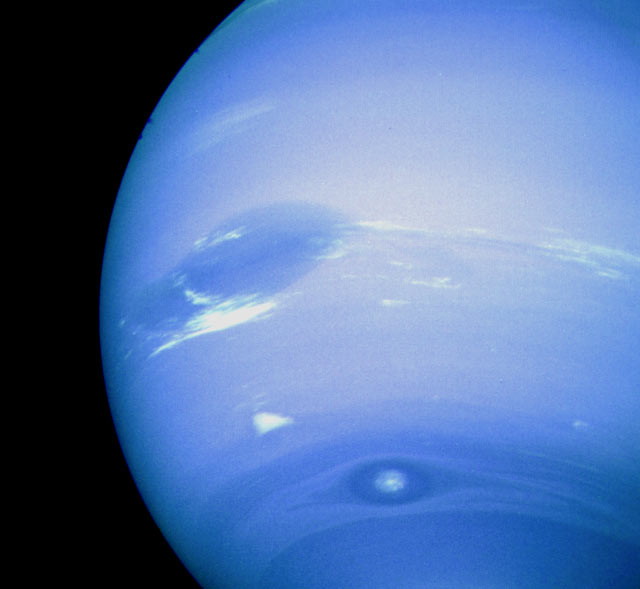What Is the Great Red Spot What Planet Has Methane as Part of Its Atmosphere Creating Blue Color
Neptune's Atmosphere: Composition, Climate & Weather
The eighth and last planet in the solar system, Neptune has an atmosphere more comparable with Uranus than with Saturn and Jupiter. The two most distant planets boast atmospheres dominated by ices. But even with a chill in the air, Neptune still manages to host some of the most extreme and violent weather in the solar system.

Atmospheric composition
Neptune's atmosphere is made up predominately of hydrogen and helium, with some methane. The methane is part of what gives Neptune its brilliant blue tint, as it absorbs red light and reflects bluer colors. Uranus also has methane in its atmosphere, but has a duller shading. Something else must be contributing to Neptune's hue, but scientists aren't certain what.
The planet has ten to a hundred times more methane, ethane, and ethyne at its equator than it does at its poles. Like other gas giants, Neptune still has much of the same atmosphere it captured at its formation.
Atmospheric composition by volume:
- Molecular hydrogen: 80 percent
- Helium: 19 percent
- Methane 1.5 percent
- Hydrogen Deuteride: 192 parts per million
- Ethane: 1.5 parts per million
Ammonia ice, water ice, ammonia hydrosulfide, and methane ice also compose Neptune's atmosphere.
Layering the atmosphere
The atmosphere of Neptune is made up of two main regions. Like the other three gas giants, the planet has no firm surface, so scientists have established that the "surface" is where the pressure is equal to the pressure found at sea level on Earth.
Just above the surface lies the troposphere. As altitude increases, temperature in the troposphere decreases. But in the next layer, the stratosphere, temperatures increase with altitude. This is related to the motion inside of the planet's core, which heats Neptune more than the rays from the distant sun. The next layer is the thermosphere, where pressures are lower. The very outer edge of the atmosphere is known as the exosphere.
Cloud patterns on Neptune
The clouds of Neptune vary with the altitude. Cold temperatures allow methane clouds to condense in the highest layers of the atmosphere. Scientists think that clouds made up of ammonia and hydrogen sulfide exist at higher pressures. Farther down, clouds of hydrogen sulfide, ammonium sulfide, ammonia, and water could exist. Clouds of water-ice may be found at pressures of 50 bars, with clouds of hydrogen sulfide and ammonia beneath them.
The highest layers contain cirrus clouds made up of frozen methane, which have been observed casting shadows on other clouds 35 miles (56 kilometers) beneath them.
Neptune also contains a haze at very high altitudes. These smog-like clouds are made up of hydrocarbons, much like smog over major cities on Earth.
Powerful storms
With winds of 1,305 miles per hour (2,100 km per hour), Neptune has some of the most extreme weather in the solar system. These winds travel three times as faster as those on Jupiter, and nine times faster as winds clocked on Earth.
Such winds drive powerful storms. When Voyager 2 observed the planet in 1989, it tracked a dark, oval storm that resembled Jupiter's Great Red Spot. The enormous weather pattern was about the size of Earth. However, while Jupiter's famous feature has lasted for hundreds of years, Neptune's first observed spot had disappeared when imaged again a few years later. Instead, the planet seems to boast a similar anticyclonic storm, with winds traveling backwards in high-pressure systems, every few years. Clouds are generated at or just below the tropopause region, which lies between the troposphere and the stratosphere.
Neptune's weather is driven in part by heating from within its core. The planet has a temperature similar to Uranus', despite being half again as far from the sun, because Uranus has some peculiarities with its internal heating that may be a result of a collision early in its life.
— Nola Taylor Redd, SPACE.com Contributor
Related:
- How Big is Neptune?
- How Far Away is Neptune?
- What is Neptune's Temperature?
- What is Neptune Made Of?
- How Was Neptune Formed?
Join our Space Forums to keep talking space on the latest missions, night sky and more! And if you have a news tip, correction or comment, let us know at: community@space.com.
Source: https://www.space.com/18922-neptune-atmosphere.html
0 Response to "What Is the Great Red Spot What Planet Has Methane as Part of Its Atmosphere Creating Blue Color"
Post a Comment